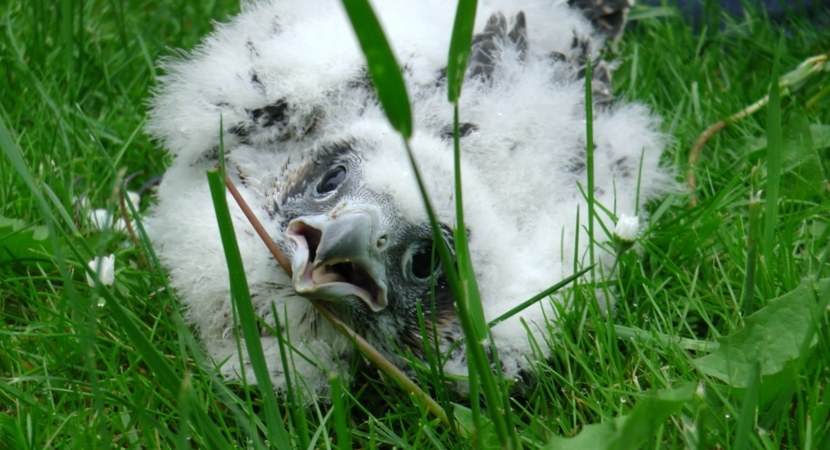PEREGRINE FALCONS HAVE BEEN RINGED
The peregrine falcon chicks from Krynki Forest District (RDSF in Białystok) have been ringed. Young birds come from another successful hatch within the framework of Polish national programme regarding resuscitation of this Accipitriformes species.
The moment of ringing was stressful not only for birds, which saw a man for the first time, but also for people who had to watch out for the female protecting her nest.
Chickens, that are to be released into the wild, are being ringed within the framework of restoration programme. Rings help assess the effectiveness of conducted protection programmes for this world’s fastest bird.
A few week old chickens were ringed with two rings – ornithological and observational. The black observational ring was placed on birds’ right leg and the green ornithological on the left one.
It is worth explaining why ornithological rings come in three colors. This indicates the habitat into which birds will be released. Green ones are intended for birds reintroduced within forest areas, red rings are destined for birds from mountainous areas, and yellow for peregrines reintroduced in cities. Each ring has its unique alphanumeric code which makes it possible to identify a given bird.
Observational rings are characterized with capital letters and numbers, which help identify a bird observed through a pair of binoculars so that catching birds alive is not necessary.
Paweł Mirski form the Eagle Conservation Committee, who has been putting the rings on Accipitriformes for nearly 10 years, helped to ring ‘peregrine youngsters’.
Additionally, Dr Elżbieta Moniuszko, a veterinary from the centre, collected the biological material, necessary to identify young birds’ gender.
This information is extremely significant to people involved in the programme- in case of peregrine falcons it’s male that chooses place to raise offspring. Those who conduct the reintroduction of the peregrine falcon programme assume that due to a high number of males released into the wild the birds which become sexually mature will return and build nests in the same area they come from.
Young falcons have already started to grow feathers. Their crops are filled with meat –it means that within two weeks they will be relocated into an artificial nest. This transfer will be the second and the last contact between birds and humans.
After the ‘removal’, birds will decide themselves when they are ready to leave the nest for the natural environment.
This is another hatching performed in “Przytulisko” - Forest Rehabilitation Centre For Wild Birds and Mammals, which functions in Krynki Forest District. Since 2012, this forest district participates in nationwide programme for reintroduction of peregrine falcon of forest ecotype.
Human support is necessary forthe preservation of this Accipitriformes species. This bird’s population crisis on an unseen scale took place in 1960s, which was caused by common use of new organochlorine pesticide, DDT in particular. This compound and its derivatives used to accumulate in the food chain.
Using DDT caused a long-term effects on falcons. One of them was deregulation of calcium metabolism. The shells of falcons’ eggs were becoming thinner and were eventually cracking underthe weight of birds brooding them. This triggered the dramatic decrease in the population of peregrine falcon (Falco peregrinus) all over the world, and even its complete extinction within the most part of North America and practically through whole Europe, especially in the central part.
In 1980s Polish vets, zootechnicians, falconers and foresters began to reintroduce this species. Currently, we may observe that the number of birds released into the wild is constantly increasing, there are also more and more new nests recorded.






